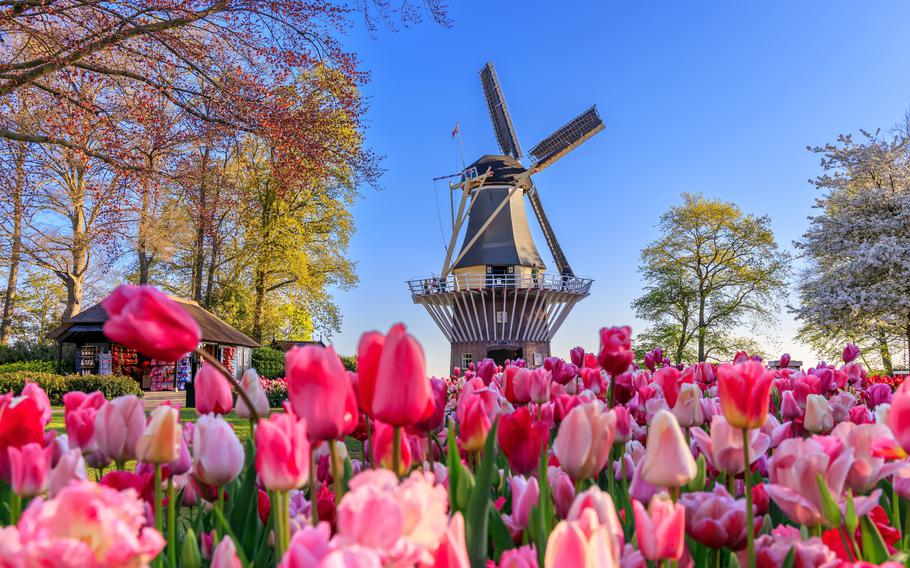
More than a million visitors admire the grounds of the Keukenhof flower gardens each year in Lisse, the Netherlands. (iStock)
Among all the wonderful and long-awaited flowers of spring, tulips occupy a special place in hearts and history. Brought to Europe from the Ottoman Empire in the middle of the 16th century, the flower whose name alludes to the shape of a turban was at some point so coveted it gave rise to a form of mass hysteria known as tulipomania. Dutch merchants would trade single bulbs at prices that rivaled the cost of a home on the banks of a canal in Amsterdam before what’s considered the world’s first speculative bubble was to burst in 1637. While tulips may no longer fetch fortunes, they’re still plenty capable of providing us with travel inspiration.
Lisse, Netherlands: They’ll stream in by bus, by bike, in cars of their own or rented ones, and when all is said and done, well over a million visitors will have completed the trek to the park and garden complex known as Keukenhof. Given the short, eight-week period in which the park is open, the tally is all the more astonishing.
Keukenhof, located some 30 miles southwest of Amsterdam, has been welcoming flower-peeping visitors for over seven decades, but its history is much older than that. The area surrounding Keukenhof, whose name translates to “kitchen garden,” served as the hunting grounds for a 15th-century noble family. In 1641, Keukenhof Castle was built, and in 1857, the estate’s gardens were subject to an English-landscape garden style makeover. In 1949, a group of flower bulb growers and exporters decided to use the grounds for a seasonal exhibition of their wares, and visitors have been pouring in to see the show of what man and nature can do together ever since.
One of the main reasons for the park’s enduring popularity is no two visits are ever the same. Each year, 7 million flower bulbs are planted across the park, including 800 varieties of tulips alone. Early bloomers such as crocuses, daffodils and hyacinths gradually give up space to tulips, which are joined by iris and allium as the end of the season approaches. Keukenhof’s 40 gardeners work tirelessly to ensure that on any given dayk no flowers past their prime are ever on view.
The park’s outdoor spaces include a windmill, sculpture garden and gently elevated paths offering sweeping vistas of the nearby tulip fields. A historical garden features heirloom varieties of tulips that have been cultivated for centuries. A maze, playground and petting zoo provide young visitors with space to roam and play. Four spacious pavilions host exhibitions dedicated to orchids, roses, chrysanthemums and other blooms.
Keukenhof is open from 8 a.m. – 7 p.m. daily through May 11 for its 2025 season. Adult entry tickets go for 20 euros, while youth ages 4 – 17 pay 9 euros to enter. The park’s website also sells packages combining entry tickets with public transportation by busses departing from Leiden, Schipol or Haarlem. Online: keukenhof.nl/en
One of Keukenhof’s busiest days of the year is sure to be April 12, the date the Bloemencorso Bollenstreek passes by. This flower parade through the blooming tulip fields is typically watched by more than a million people lining its 26-mile route between the towns of Noordwijk and Haarlem. The parade is made up of 14 flower-bedecked floats, about 30 decorated vehicles and numerous marching bands. The parade sets off from Noordwijk at 9 a.m. and passes by Keukenhof shortly after 3:30 p.m. On the following day, the floats remain on display in Haarlem until 5 p.m. Online: bloemencorso-bollenstreek.nl/en
While in no way close to the grand scale of Keukenhof, other corners of Europe also offer opportunities to admire tulips.
Groot-Bijgaarden, Belgium: The park of a castle sets the scene for Floralia, an annual spring flower exhibition starring tulips backed by daffodils, hyacinths and other blooms spread out beneath the branches of ancient trees. More than a million bulbs go into the making of these flower beds bursting with color and scent. These castle grounds in a Brussels suburb can be visited from 10 a.m.-6 p.m. daily through May 2. Adult tickets go for 17 euros; entry for children ages 6-15 costs 8 euros. Online: floralia-brussels.be/en
Morges, Switzerland: This city on the shores of Lake Geneva, west of Lausanne, invites visitors to stroll through its park in which more than 350 varieties of tulips gently sway. Water serves as the theme of this year’s exhibition. A large tent set up in the Parc de l’Indépendance offers artisanal products from the surrounding Vaud region. Entry is free. Online: tinyurl.com/2ya37fzf
Baden-Baden, Germany: This upscale town known for spas and casinos adds flowers to its mix of offerings each spring, as the tulip garden along the Lichtentaler Allee comes into its own. Some 6,500 tulips in 46 different varieties bloom alongside daffodils, violets and forget-me-nots. Entry is free. Online: tinyurl.com/yc7j7tsk